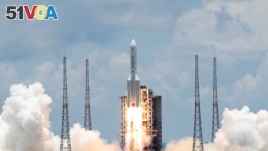23 July 2020
An unmanned Chinese spacecraft left Earth Thursday on a yearlong trip to the planet Mars. The launch marks the beginning of one of China's most important space missions yet.
China's national space agency launched the spacecraft, called Tianwen-1, from the Wenchang Spacecraft Launch area on Hainan Island. Hundreds of people were watching and cheered as it rose into the sky.

The Long March 5 Y-4 rocket, carrying an unmanned Mars probe of the Tianwen-1 mission, takes off from Wenchang Space Launch Center in Wenchang, Hainan Province, China July 23, 2020. (REUTERS/Carlos Garcia Rawlins)
The name Tianwen means "Heavenly Questions" or "Questions to Heaven" in Mandarin Chinese. The spacecraft is expected to reach the Red Planet by February of next year.
Once it begins orbiting the planet, a probe will leave the spacecraft and attempt to land on the Utopia Planitia area of Mars. Space agency officials say the probe will release a small solar-powered rover. They said the vehicle will explore the planet's surface for about three months.
A successful landing would make China only the second nation to place a spacecraft on the Martian planet. The United States has landed eight probes on Mars since 1976.
China would also be the first to successfully orbit, land and deploy a vehicle in the same mission.
This is China's first independent mission to Mars. A 2011 mission failed when a Russian rocket carrying a Chinese orbiter had problems after launch, and was unable to escape Earth's orbit.
Last year, China's Chang'e-4 spacecraft became the first to make a landing on the far side of the moon.
The Tianwen-1 is the third mission to Mars this year. On Monday, Japanese engineers launched a rocket. It is carrying an orbiter developed and built by the United Arab Emirates. The U.S. space agency NASA is set to launch a new Martian vehicle, named Perseverance, on July 30.
Another solar system
In a separate development, scientists have released, what they say, is the first image ever captured by a telescope of more than one planet orbiting a sun-like star. The European Southern Observatory (ESO) said Wednesday that the image came from its Extremely Large Telescope, in Chile's Atacama Desert.
The researchers said the star is part of the constellation Musca, or Fly. They believe it is just about 17 million years old. That is young when compared to Earth's sun, which is believed to be 4.5 billion years old.
The newly discovered solar system is about 300 light-years away from Earth.
A report on the discovery was published Tuesday in The Astrophysical Journal Letters. Lead researcher Alexander Bohn of Leiden University described the star as very young and much like our own sun. He added that taking direct images provides the best chance to find life outside our solar system, if it exists.
I'm Anna Mateo.
VOA News reported this story. Susan Shand adapted it for Learning English. George Grow was the editor.
_______________________________________________________________
Words in This Story
spacecraft - n. a vehicle designed to fly in outer space
mission - n. a goal or a serious undertaking
probe - n. a vehicle that explores a planet's service
solar-powered - adj. something that draws its power from the sun
light-years - n. a unit of measure used to explain astronomical distances
constellation - n. a group of stars that appear to form pattern